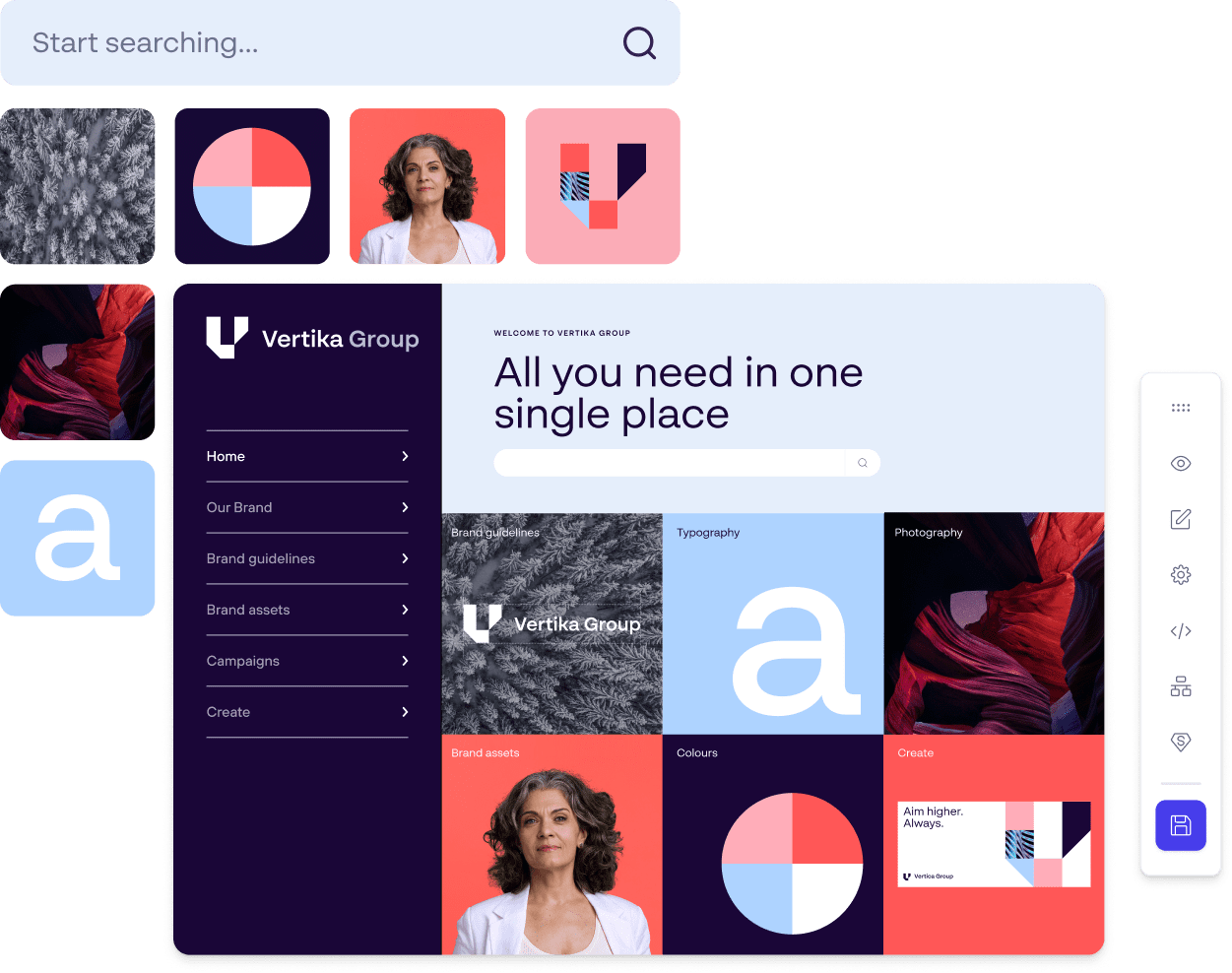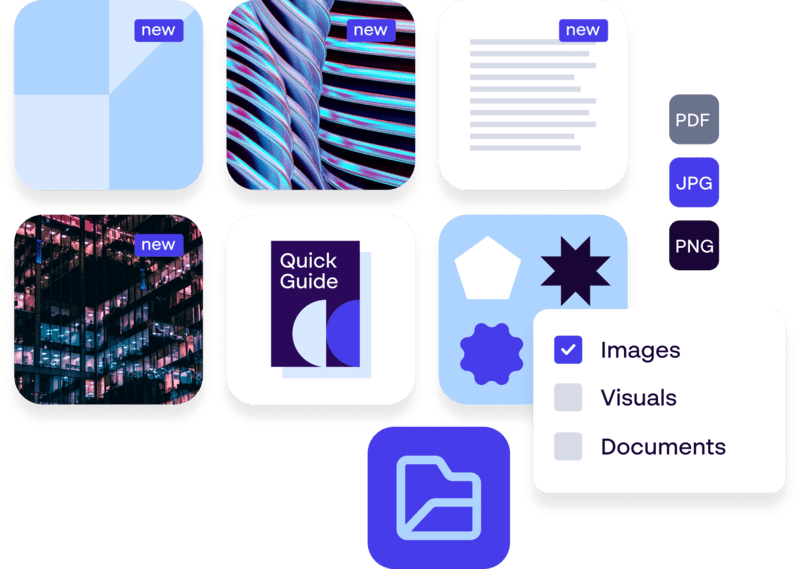In a digital-first world, the volume of content created by organizations is staggering. Marketing teams, regional offices, agencies, and partners all produce campaigns, documents, and assets at speed. But not every digital file qualifies as a brand asset. The difference between a simple piece of content and an official brand asset is critical—and it defines how your brand is perceived in the market.
Brand Asset Management (BAM) software provides the framework to protect brand identity, ensure brand consistency, and scale digital content creation without compromise. It is more than a storage solution; it is the infrastructure that connects governance with creativity, enabling brands to grow equity while accelerating campaigns.
What is Brand Asset Management?
A Brand Asset Management system is a centralized hub that organizes, controls, and distributes materials tied directly to brand identity.
While traditional Digital Asset Management (DAM) systems are designed to handle a wide variety of content, Brand Asset Management is a subset of a DAM’s capabilities which focuses specifically on the creative assets that carry your identity into the market.
Branding teams, or departments responsible for brand consistency, must deliver logos, color palettes, typography, photography, tone of voice examples, and approved templates which live at the heart of these systems. Every output—from localized social media posts to video content marketing campaigns—remains on-brand, reinforcing strategy and messaging consistency.
By combining storage, approval workflows, and brand guidelines into one ecosystem, these systems transform how organizations safeguard reputation while supporting agile content creation.
When do digital assets become brand assets?
Not every piece of content created within an organization starts as a brand asset. A digital file only becomes one when it represents the brand officially, reflects identity, and is governed for compliance.
Think of a stock photo: on its own, it is a generic asset. Once placed into an approved campaign template, it becomes a brand asset. A datasheet drafted in plain text is just content. When it is formatted using the official template and validated for sales use, it transforms into a brand asset.
The transition happens when:
- Core identity elements such as logos, typography, or color palettes are applied
- Approval workflows confirm the file as an official representation
- The asset is designed for repeated use across campaigns or channels
- Governance is applied to ensure consistent branding and protect equity
Because these materials directly influence brand reputation, they demand stricter version control, access management, and workflow automation than ordinary content.
Key features of Brand Asset Management software
A strong Brand Asset Management system brings together several components that work in harmony to protect brand identity and accelerate content creation. Each plays a distinct role in supporting governance, consistency, and scale.
- Brand portals are the front-end gateways to a well organised DAM, to extend role-based access to internal and external stakeholders—agencies, vendors, journalists, and franchisees—through curated environments.
- Digital asset library features create a secure, searchable home for approved brand assets, ensuring teams can always find the right file quickly.
Brand guidelines embed rules and standards directly into the system, showing users not just what to use but how to use it correctly. - Brand compliance tools enforces standards automatically, with approval workflows, audit trails, and expiration management to protect reputation at scale.
The following sections explore these features in more depth, showing how they come together to form a complete ecosystem for managing brand assets across industries and channels.
How brand portals distribute assets and guidelines
A brand portal makes approved materials accessible to external stakeholders. Specific pages can be customized for particular teams, regions or stakeholders to see the information in the context they need to see it.
Alternatively, role-based permissions can give access to certain pages. Either way, employees, marketing teams, agencies, vendors, journalists, and franchisees interact with a curated environment that provides only what they need. For example:
- Agencies can access campaign kits with usage guidelines embedded.
- Vendors download print-ready files with specifications, minimizing errors and revision cycles.
- Journalists receive press packs containing current, approved assets to ensure accurate coverage.
- Franchisees gain access to parent brand elements alongside localized content for seasonal campaigns.
By providing simplified, role-specific access, portals empower external partners while protecting identity.
Digital asset library software for brand assets
A digital asset library is the secure, cloud-based home for your approved brand assets – and essentially the result of an effective Digital Asset Management system. Unlike simple file storage, it is structured to support governance, brand ecosystems, and messaging consistency.
AI metadata tagging and AI-driven search make retrieval simple, reducing wasted time. Analytics and reporting reveal how assets are used and where content optimization is needed. The system also accommodates complexity—managing portfolios, sub-brands, regional variations, or co-branding scenarios.
Also GDPR or other data protection laws must be followed with consent management ensuring that the library of digital assets is in full compliance.
By aligning library structure with brand strategy and compliance, organizations ensure that every creative asset supports both governance and content creation.
Brand guidelines software features
Brand guidelines software takes standards beyond static PDFs, and into your brand portal.
Within the system, guidelines are embedded contextually and interactively. When downloading a logo, users see spacing rules, prohibited uses, and approved backgrounds. Photography assets are accompanied by composition and styling instructions.
This contextual delivery prevents misinterpretation and reduces errors. Advanced systems enforce brand compliance through approval workflows, restrict downloads in incorrect formats, and notify managers when high-risk assets are accessed.
The result is clear stakeholder alignment: everyone understands not just what assets exist, but how to use them correctly.
Brand compliance software: maintaining standards at scale
Compliance is one of the most pressing challenges in brand management. Modern systems embed compliance features into every workflow, protecting both legal standing and brand equity.
Usage rights management ensures licensed assets are used within agreed terms. Automated guideline enforcement detects violations, such as incorrect logo placement or unauthorized color combinations. Audit trails track every change and access, providing accountability.
Pre-approved templates minimize risks by guiding digital content creation within set parameters. For regulated industries, compliance modules enforce mandatory disclosures. Expiration management prevents outdated or off-brand content from slipping into circulation.
Key benefits of Brand Asset Management
Organizations that implement Brand Asset Management realize measurable benefits. Consistency across platforms strengthens recognition and trust. Teams work more efficiently, spending less time searching for files or recreating content. Campaigns launch faster thanks to workflow automation and approved templates.
Brand equity grows as every touchpoint reinforces strategy and identity. Collaboration improves when internal and external stakeholders align around a single ecosystem. Most importantly, access controls and analytics protect reputation by preventing misuse and ensuring governance.
Use cases across industries
The value of a Brand Asset Management system extends across sectors, providing both governance and agility in equal measure.
In retail and consumer goods, BAM systems organize identity elements alongside approved product photography, ensuring that e-commerce, in-store, and social campaigns all carry a consistent look and feel.
See how PepsiCo uses Papirfly to refresh their brand for employees
For franchises, centralized control of logos, colors, and signage is paired with customizable templates for local campaigns. Franchisees gain flexibility within defined guardrails, protecting brand equity while enabling market responsiveness.
See how O’Leary’s uses Papirfly to maintain brand consistency across every franchise.
Healthcare organizations rely on BAM to manage patient education resources and provider communications, ensuring every material distributed meets compliance requirements and regulatory approval.
See how Orkla Health uses Papirfly to create portals for dozens of sub-brands.
In Financial Services, strict approval workflows, version control, and audit trails protect both brand integrity and regulatory compliance, while keeping messaging consistent across branches and markets.
See how Rabobank uses Papirfly to grow global market share with localized on-brand content.
Manufacturing and technology companies with multiple product lines use BAM systems to clarify brand hierarchies, manage sub-brands, and align all creative assets with the overarching brand strategy.
See how STIHL Switzerland elevates its dealer marketing across 600 dealers.
Choosing the right Brand Asset Management software
When selecting a system, decision-makers should focus on features that support governance. Can the solution manage brand hierarchies, sub-brands, and co-branding? Does it automate workflows, integrate with marketing operations software, and scale as needs grow?
User experience must also be prioritized. If a system is cumbersome, adoption falters. Analytics and reporting should deliver actionable insights into optimization, while role-based access ensures sensitive materials are safeguarded.
As mentioned, Brand Asset Management is a subset, and indeed the front-end DAM of a Digital Asset Management system. With this in mind, it’s important to ensure your DAM solution sets the right foundation for your teams. Luckily, we can help you with our buyer’s guide.
Not sure what to look for in a DAM?
We’ve got you covered
Not sure what to look for in a DAM?
We’ve got you covered.
Not sure what to look for in a DAM?
We’ve got you covered.

Implementation best practice checklist
Implementing a Brand Asset Management system requires both planning and change management.
- Begin with a brand audit to catalog assets and identify gaps.
- Create a taxonomy supported by metadata that improves searchability.
- Define governance policies that outline who uploads, approves, and accesses assets.
- Embed guidelines directly alongside files rather than in standalone documents.
- Train users not only in how the system works, but why it matters for equity and reputation.
Pilots allow organizations to test workflows before rolling out broadly. Long-term success requires ongoing updates, audits, and refinements.
Integrating with content marketing tools and workflow software ensures asset management connects seamlessly with campaign delivery.
Why Brand Asset Management is essential for the future of your business
As AI capabilities converge with automation and integration, brand asset management systems are becoming the backbone of modern marketing infrastructure. Connections with marketing automation platforms, video content marketing tools, and multichannel distribution software ensure that governance and creativity happen side by side.
The result is a brand ecosystem where brand consistency, compliance, and speed are not manual tasks but built-in safeguards. By transforming scattered files into governed environments, organizations protect identity, maintain trust, and scale digital content creation with confidence.
The foundation of success remains clear: identify which files truly qualify as brand assets, apply governance, and invest in the right technology. With a future shaped by AI and automation, organizations that prioritize brand asset management today will build stronger experiences, protect reputation, and sustain brand equity tomorrow.
Discover Papirfly’s Brand Asset Management solution
Your gateway to modern brand governance.
Discover Papirfly’s Brand Asset Management solution
Your gateway to modern
brand governance.
Your gateway to modern
brand governance.

FAQs
Traditional Digital Asset Management systems store all kinds of content. Papirfly focuses on brand-critical assets only—logos, templates, guidelines, and campaign materials—ensuring every file reinforces your brand identity. Our platform combines storage with governance, workflows, and brand portals, so teams and partners always work with approved, on-brand materials.
Papirfly manages all identity-defining assets, including logos, typography, color palettes, photography, templates, brand guidelines, and campaign-ready creative. Unlike generic storage, our system links assets directly to contextual usage rules—helping teams apply them correctly every time.
With Papirfly, brand consistency is built in. Approved templates, automated workflows, and clear governance make it simple for local teams, agencies, and franchisees to create on-brand content for their markets. Every output—from presentations to video content—stays aligned with your global standards.
Papirfly enforces brand compliance automatically. Features include approval workflows, version control, expiration management, and audit trails. AI-driven tagging, facial recognition, and GDPR consent management ensure assets are not only on-brand but also legally compliant.
Papirfly supports organizations across retail, financial services, healthcare, technology, and franchising—sectors where consistency, compliance, and speed-to-market are critical. Our system adapts to complex brand hierarchies and regional variations, giving every team the right assets at the right time.
Most organizations see value within weeks. We start with a brand audit to align your core assets and guidelines, then roll out through pilot programs to ensure adoption. With built-in training and support, teams are empowered to create, govern, and distribute brand assets confidently from day one.
Table of contents:
- What is Brand Asset Management?
- When do digital assets become brand assets?
- Key features of Brand Asset Management software
- How brand portals distribute assets and guidelines
- Digital asset library software for brand assets
- Brand guidelines software features
- Brand compliance software: maintaining standards at scale
- Key benefits of Brand Asset Management
- Use cases across industries
- Choosing the right Brand Asset Management software
- Implementation best practice checklist
- Why Brand Asset Management is essential for the future of your business
- FAQs


